Jurassic
Oyster–microbial rolling stones from the Upper Jurassic (Kimmeridgian) of Poland
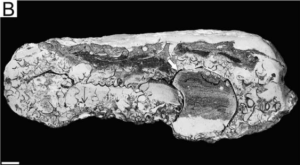
Zatoń, M. & Machalski, M., 2013. Oyster–microbial rolling stones from the Upper Jurassic (Kimmeridgian) of Poland. Palaios, 28: 839-850.
Abstract: Oyster–microbial rolling stones (ostreoliths) from the Upper Jurassic (Kimmeridgian) of Sulejów and Małogoszcz, Poland, are described and interpreted in terms of their origin and development. The ostreoliths are composed mainly of small-sized oysters (Nanogyra nana) that initially encrusted bivalve or ammonite shells. These structures were frequently overturned during their further growth by hydrodynamic agents. The oyster shells are covered by a thin crust that is suggestive in appearance of a microbial mat. We postulate that the mats not only bound the shells, but also induced early cementation of the sediment infill, thereby triggering the rapid lithification and rigidity of ostreoliths. This interpretation is supported by the presence of bivalve borings that cut the shells, microbial crust and internal sediment infill. The oyster–microbial association provided favorable conditions under which hardground biota thrived in a soft-bottom setting which was otherwise inimical to such organisms. These hardground biota are represented by a variety of encrusters (foraminifera and foraminifera-like problematica, plicatulid bivalves, cyclostome bryozoans, serpulids, and thecideid brachiopods) and borers (bivalves, bryozoans, and phoronids). Ostreoliths from Sulejów are of smaller size, and with a less-developed oyster cortex, than those from Małogoszcz. This may be due to a higher frequency of physical disturbance (storms) at Sulejów which halted ostreolith development at earlier phases than at Małogoszcz. A large oyster buildup recorded previously from Brzegi, close to Małogoszcz, suggests that, under favorable conditions, ostreoliths could eventually have transformed into stationary, patch-reef–type structures.
Palaeoenvironmental reconstruction of Bathonian (Middle Jurassic) ore-bearing clays at Gnaszyn, Krakow-Silesia Homocline, Poland
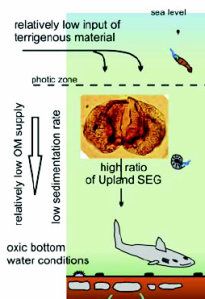
Gedl, P., Kaim, A., Leonowicz, P., Boczarowski, A., Dudek, T., Kędzierski, M., Rees, J., Smoleń, J., Szczepanik, P., Sztajner, P., Witkowska, M. and Ziaja, J. 2012. Palaeoenvironmental reconstruction of Bathonian (Middle Jurassic) ore-bearing clays at Gnaszyn, Krakow-Silesia Homocline, Poland. Acta Geologica Polonica, 62(3): 463-484.
Abstract: Multidisciplinary studies of the Middle-Upper Bathonian ore-bearing clays at Gnaszyn revealed variable palaeoenvironmental conditions during the deposition of this seemingly monotonous sequence. We interpret the conditions in the bottom environment and the photic zone, and also evaluate the influence of the adjacent land areas, based on sedimentology, geochemistry, sporomorphs and palynofacies composition, benthic (foraminifera, gastropods, bivalves, scaphopods, echinoderms), planktonic (calcareous nannoplankton, dinoflagellate cysts), and nektonic (sharks) fossils. The Gnaszyn succession originated relatively close to the shore, within reach of an intense supply of terrestrial fine clastic and organic particles. The latter are mainly of terrestrial origin and range from 1.5 to 2.5 wt.%. The precise water depth is difficult to estimate but most likely ranges from several tens of metres to a few hundred metres. All fossil groups show minor changes throughout the succession. As the climate seems to have been quite stable during this period we consider sea-level fluctuations to have been the main factor responsible for the changes. The terrestrial input, including freshwater and land-derived clastic and organic particles (sporomorphs and cuticles), increased during periods of sea-level lowstand. As a consequence, stress conditions (lower salinity, higher nutrient availability, lower water transparency) in the photic zone caused blooms of opportunistic planktonic taxa. Furthermore, a faster sedimentation rate led to oxygen depletion and deterioration of the living conditions in the bottom environment due to an increased accumulation of organic matter. As a result, the benthic biota became taxonomically impoverished and commonly dominated by juvenile forms. During periods of high sea level, the source areas were shifted away from the basin, resulting in a decrease in the terrestrial influx, increase in the salinity of surface waters, the appearance of more diverse phytoplankton assemblages, a lower sedimentation rate, and an improvement of living conditions at the bottom.
Calcareous nannofossils from the Bathonian (Middle Jurassic) ore-bearing clays at Gnaszyn as palaeoenviron-mental indicator, Kraków-Silesia Homocline, Poland
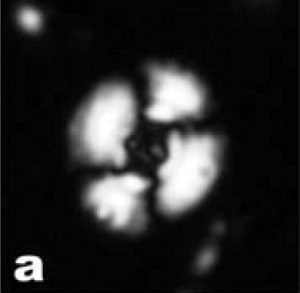
Kędzierski, M., 2012. Calcareous nannofossils from the Bathonian (Middle Jurassic) ore-bearing clays at Gnaszyn as palaeoenviron-mental indicator, Kraków-Silesia Homocline, Poland. Acta Geologica Polonica, 62(3): 421-437.
Abstract: Qualitative and quantitative studies on calcareous nannofossils have been carried out on the Middle-Upper Bathonian succession of Gnaszyn (Kraków-Silesia Homocline, Częstochowa region). The nannofossil assemblages are moderately or well-preserved and are dominated by Watznaueria britannica; also common are Staurolithiteslumina and Zeugrhabdotus erectus. The presence of delicate nannofossil forms together with dissolution- resistant taxa shows that the changes in composition of some of the nannoplankton assemblages reflect original variations. The frequency and diversity changes of the calcareous nannofossil assemblages have been interpreted in relation to fluctuations of sedimentation rate versus changes in trophic conditions within the photic zone. The highest diversity assemblages contain a high percentage of palaeofertility indicators, and are impoverished in the genus Watznaueria. This is interpreted as a reflection of a lower sedimentation rate and more stable, possibly mesotrophic conditions within the photic zone. On the other hand, W. britannica-dominated assemblages with low species diversity may represent more unstable environments with a high influx of terrestrial material related to a high sedimentation rate and a high nutrient influx, i.e. eutrophic conditions in the photic zone.
Unusual tubular fossils associated with microbial crusts from the Middle Jurassic of Poland: Agglutinated polychaete worm tubes?
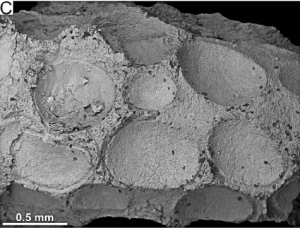
Zatoń, M., Kano, Y., Wilson, M. A., & Filipiak, P., 2012. Unusual tubular fossils associated with microbial crusts from the Middle Jurassic of Poland: Agglutinated polychaete worm tubes?. Palaios, 27(8): 550-559.
Abstract: Intriguing fossils encrusting oncoids and exhumed carbonate concretions are described from the Middle Jurassic (Bathonian) of Poland. The fossils, up to a few millimeters in diameter and preserved in a form of calcium carbonate, are characterized by a tubular, elongate shape with the external surface covered with distinctive semicircular to oval concavities. These tubes do not match any known fossils and do not represent trace fossils sensu stricto. They are similar to serpulid and/or sabellid polychaetes with which they are associated. The latter, however, have calcitic tubes and none are known to possess the concave structures that characterize the tubular fossils. The shape of the concavities and the presence of a carbonate lining within them suggest that the tubular fossils were originally covered with ooids, a few of which are still preserved in the concavities. These Middle Jurassic fossils may represent the fossilized remnants of agglutinated tubes formed by polychaete worms. Their greatest abundances are noted on media bearing thick microbial crusts (oncoidal in nature) on which they often form dense aggregations. This may indicate that the tube-building worms selected such media not only because they provided a suitable hard surface for settlement, but also because they were a rich source of food in the form of both microbes (Cyanophyta) and other organic matter present in the microbial mats. The selectivity of only ooids for tube building makes them dissimilar to any known recent tube-building polychaetes and, thus, the Middle Jurassic representatives are nonactualistic with respect to particle selection for the tube formation.
Middle Jurassic (Bathonian) encrusted oncoids from the Polish Jura, southern Poland
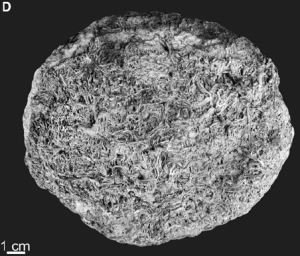
Zatoń, M., Kremer, B., Marynowski, L., Wilson, M.A., & Krawczyński, W., 2012. Middle Jurassic (Bathonian) encrusted oncoids from the Polish Jura, southern Poland. Facies, 58(1): 57-77.
Astract: Oncoids from two localities (Ogrodzieniec and Blanowice) of the Polish Jura, southern Poland, have been investigated with respect to their genesis and paleoecology. These oncoids occur within Middle Jurassic (Bathonian) deposits. Those from Ogrodzieniec are large, elliptical, and embedded within a presumably condensed carbonate bed. Those from Blanowice, on the contrary, are significantly smaller, irregular to box-like in shape, and occur within the ore-bearing clays. The oncoids from both localities consist of a distinct carbonate core and laminated cortex that is significantly thicker and better preserved in the Ogrodzieniec oncoids. SEM and optical microscopic investigation of the oncoid cortices revealed the presence of carbonate and silicate layers with web-like structures similar to those occurring in recent cyanobacterial microbialites. Thus, the oncoid cortices investigated may have formed in a photic zone environment with the aid of coccoid and filamentous cyanobacteria. Oxic conditions prevailed during oncoid cortex formation within the siliciclastic setting, which is manifested by low total organic carbon content, high pristane/phytane (Pr/Ph) ratio, and significant predomination of the C31 homohopanes. On the cortices’ surfaces, as well as between particular laminae, various encrusting organisms have been found. The encrusters, dominated by serpulids and bryozoans, are cryptic species that inhabited the undersides and recesses of the oncoids. Their presence on both the upper and lower surfaces of the oncoids indicates that the oncoids were episodically overturned on the seafloor. The much better developed cortex lamination and much higher diversity and abundance of encrusters in the Ogrodzieniec oncoids may point to better trophic conditions prevailing in a shallower marine environment characterized by transparent waters, as opposed to a deeper siliciclastic environment with less transparent waters and probably worse trophic conditions prevailing during formation of the Blanowice oncoids.
Callovian (Middle Jurassic) cyclostome bryozoans from the Zalas Quarry, southern Poland
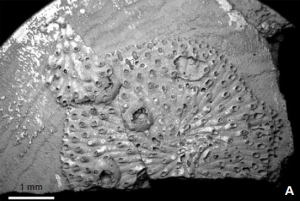
Zatoń, M., Hara, U., Taylor, P.D. & Krobicki, M., 2013. Callovian (Middle Jurassic) cyclostome bryozoans from the Zalas Quarry, southern Poland. Bulletin of Geoscience, 88 (4): 837-863.
Abstract: The specimen-rich and diverse bryozoan fauna from the Callovian hardground at Zalas Quarry in southern Poland is described. Twenty-two taxa of cyclostomes are recorded, of which three species are proposed as new: Microeciella calloviana, Reptomultisparsa viskovae and Mesonopora walteri. Due to preservational problems and an insufficient number of fertile colonies, species-level determination of fourteen forms was not possible. The most common bryozoans present are sheet-like bereniciform colonies, with uniserial runners and oligoserial ribbons less abundant. The number of the Callovian taxa present in the Zalas Quarry is very similar to the Upper Bathonian-Lower Callovian bryozoan assemblage from the classic locality of Balin in southern Poland. Taking the strictly Callovian age into account, the Zalas assemblage is the most diverse for that age ever noted.
The oldest record of predation on echinoids: evidence from the Middle Jurassic of Poland
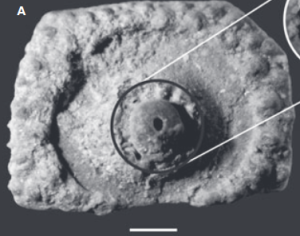
Borszcz, T., & Zatoń, M., 2013. The oldest record of predation on echinoids: evidence from the Middle Jurassic of Poland. Lethaia, 46(2): 141-145.
Introduction: Competition and predation are regarded as important ecological and evolutionary factors. The importance of competition (Barnes & Kukliński 2003, 2004) and especially predation (see Kowalewski & Kelley 2002; Kelley et al. 2003 for comprehensive reviews) is clearly reflected in the ability of predators to regulate population densities and abundance of individuals. It controls faunal distribution and structure, and functions as a causative mechanism of evolution due to adaptive (induced) responses in prey (e.g. spines, thicker shells, ornamentation, motile life style, infaunalization). Bambach (2003) summarized that predators affect virtually every major ecological and evolutionary aspect (Kelley et al. 2003). This led Vermeij (1977, 1987) to recognize the escalation of predation as a driving force of the so-called ‘Mesozoic Marine Revolution’ (MMR).